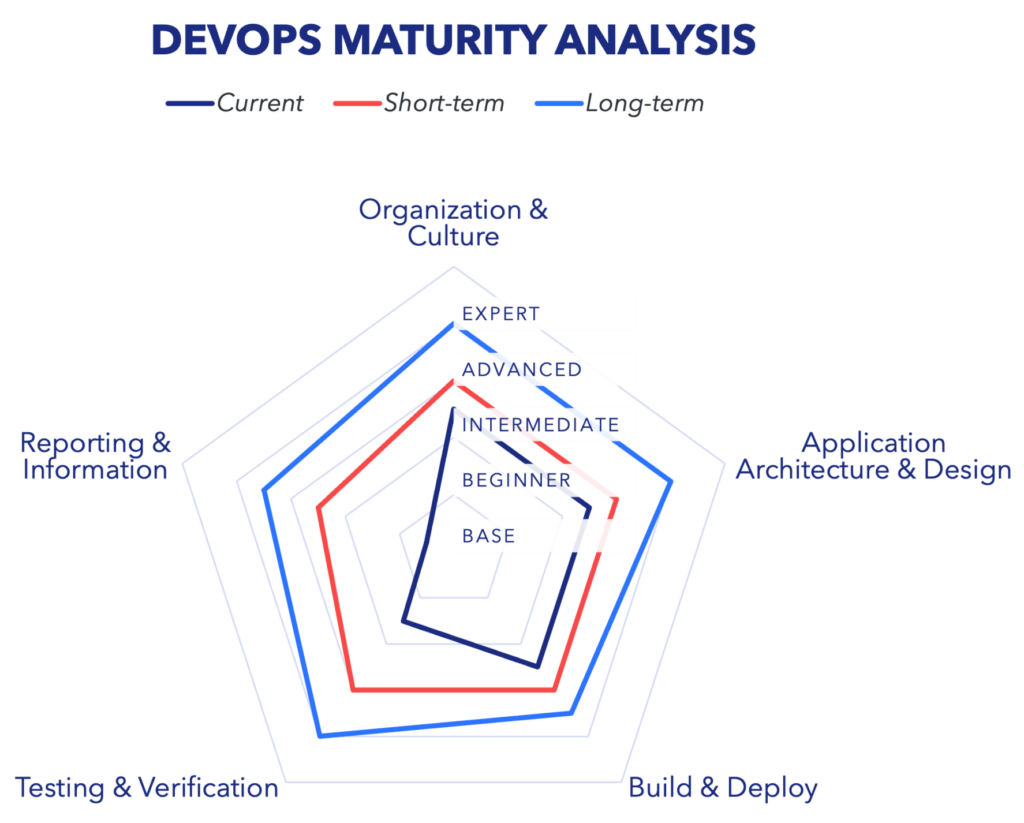In the ever-evolving landscape of software delivery, businesses are increasingly drawn to the transformative power of DevOps. According to Nagarro’s State of DevOps Report 2022, “Almost 50% of organizations can be classified as high or even elite performers, a significant 30% increase as compared to last year’s results.”
However, many organizations need help comprehending and evaluating their own DevOps capabilities. In the same report, “Most (60%) organizations struggle to achieve a high deployment frequency, which costs them valuable time, flexibility and overall agility.”
Technology leaders like CIOs, VPs of IT Operations, and Directors of IT often seek clarity on measuring the effectiveness of their DevOps capability and gauging the maturity of their processes. So, how can you deconstruct DevOps and evaluate progress in maturing the function within your company?
For organizations of various sizes, the evolution of DevOps involves intricate application deployments and the construction of comprehensive DevOps capabilities designed to meet the specific needs and nuances of each enterprise.
Take, for example, a scenario where an organization with 300+ custom pipelines maintained by diverse teams faces challenges with some pipelines being outdated and lacking in automated testing and compliant security scanning. This can result in varying code quality entering production, leading to instability and application outages, directly impacting the smooth functioning and success of the business. By implementing a robust and scalable automated process, the organization can significantly reduce build and deploy efforts, address code quality and security comprehensively, and ensure testing protocols are upheld. The outcome was a streamlined, standardized, and secure pipeline landscape that prevented business disruptions.
DevOps across the software development lifecycle
DevOps, as a term, carries different interpretations for different organizations, often leading to misconceptions about what truly constitutes an effective DevOps process. As the wise people of the DevOps world have said many times many ways:
“DevOps is the union of people, process, and technology to enable continuous delivery of value to your end users.”
– Many different people over the years
The software development lifecycle (SDLC) embodies a continuous delivery cycle, progressing through Plan, Build, Validate, Release, Operate, and Security. Each cycle is repeated for numerous products and projects within an organization. Every stage of this SDLC has associated DevOps components, visualized in the accompanying image.

DevOps maturity model
To measure where an organization stands on Pariveda’s DevOps Maturity Model and to intentionally plan DevOps capability growth, one must analyze the elements above. This model comprises five pillars:
Pillar 1
Organization & Culture
This pillar evaluates the collaborative and innovative nature of the organization and its culture. It assesses team collaboration, adoption of agile methodologies, and effective utilization of tools and technologies.
Pillar 2
Application Architecture & Design
Each application’s architecture and design are evaluated for resilience, scalability, maintainability, and adherence to technology standards.
Pillar 3
Build & Deploy
Emphasizing efficient and automated processes for reliable, swift software delivery, this pillar assesses the degree of automation, responsiveness to customer needs, and the role of IT in the DevOps process.
Pillar 4
Testing & Verification
Focused on implementing robust testing practices to ensure software release quality and reliability, this pillar evaluates testing types, coverage measurement, and test automation.
Pillar 5
Reporting & Information
This pillar encompasses both DevOps process and application reporting. It evaluates deployment details, technology usage, error reporting, alerts, usage metrics, and data-driven decision-making.

Combining the elements and the maturity model
To comprehend the current state and alignment with the DevOps Maturity Model, organizations must evaluate each DevOps component. Consider Quality Management as an example. If the software delivery process relies heavily on manual procedures with minimal testing, the quality management practice is likely inadequate. Overlaying this with the maturity model reveals that the organization may be at the base level in the Testing & Verification pillar.
Organizations can use the DevOps components to analyze their status and future trajectory over the next 3-5 years.
Organizations can use the DevOps components to analyze their status and future trajectory over the next 3-5 years. For organizations with central IT and decentralized application teams, the analysis should cover both central IT DevOps capabilities and DevOps usage within app teams.
Post-analysis, organizations gain insights into where DevOps investments should be directed for future alignment. The graph below illustrates an analysis example that informed decisions regarding ROI and organizational direction.

Empowering your DevOps journey
Has your organization unlocked the full potential of your organization’s software delivery? The world of DevOps offers a transformative approach that can revolutionize how you create, deliver, and manage software. The rapidly changing landscape of technology demands agile and efficient software practices. Waiting too long to optimize your DevOps journey might mean missing out on critical opportunities to outpace the competition, deliver value to your users, and respond to market shifts with unmatched speed. If you find yourself grappling with questions about the effectiveness of your DevOps capabilities or the maturity of your processes, it’s time to take action.
Success in your DevOps journey requires starting with a personalized assessment of your current state to identify strengths, uncover challenges, and chart a clear path toward maturity. When you’re ready to begin your DevOps journey, we are here to help you navigate the way for a more agile and efficient future.


















